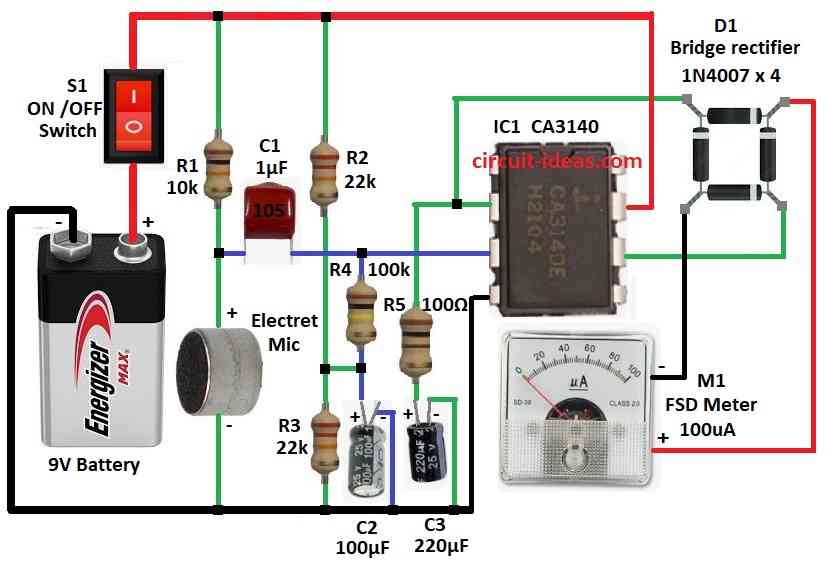Sound Pressure Level Meter Circuit using IC CA3140 is device to check how loud sound is in one place.
It shows sound level with visuals.
It is useful for audio testing, noise check and sound work.
This article shows simple way to make it using condenser mic, op-amp and FSD meter for correct sound measure.
Circuit Working:

Parts List:
| Component | Specification | Quantity |
|---|---|---|
| Resistors | 10k, 100k, 100Ω 1/4 watts | 1 each |
| 22k 1/4 watt | 2 | |
| Capacitors | Electrolytic 1µF, 100µF, 220µF | 1 each |
| Semiconductors | IC CA3140 | 1 |
| Electret Mic | 1 | |
| ON/OFF Switch | 1 | |
| Bridge Rectifier 1N4007 Diodes | 4 | |
| Full Scale Deflection FSD Meter 100µA | 1 | |
| Battery 9V | 1 |
Circuit runs on 9V battery.
ON/OFF switch is used to start or stop it.
Electret mic hears sound and changes it to electric signal.
Signal goes through capacitor C1 1µF to amplifier.
IC1 CA3140 op-amp makes weak signal strong.
Resistors R1 10k, R2 22k, and capacitor C2 100µF control how much signal is boosted.
R4 100k keeps amplifier stable and balances input and output.
IC1 output goes to diode bridge D1 and changes AC to DC based on sound level.
Capacitor C3 220µF smooths DC signal.
Final DC goes to FSD meter M1 which shows sound pressure in microamperes (µA).
Formulas:
Amplifier Gain Formula:
Gain = R4 / (R2 + R3)
where,
- R4 is the feedback resistor
- R2 and R3 is the input resistors
This tells how much op-amp boosts signal.
Example:
R4 = 100k, R2 + R3 = 22k + 22k = 44k
Gain = 100k / 44k = 2.27
Signal from mic gets 2.27 times stronger.
τ = R × C
where,
- R is the resistance
- C is the capacitance
This tells how fast capacitor charges/discharges.
Example:
C3 = 220µF, R5 = 100Ω
τ = 100 × 220 × 10⁻⁶ = 0.022 sec
This helps smooth out the signal.
Meter Calibration:
Voltage ∝ Sound Pressure Level
More loud sound means more DC voltage
Meter M1 shows louder sound with bigger needle move
Example: 1V means full scale which is max sound level.
How to Build:
To build a Sound Pressure Level Meter Circuit using IC CA3140 following are the steps to follow for assembling.
- Gather all parts shown in the circuit diagram.
- Connect pin 2 of IC1 CA3140 to one side of R5.
- Other side of R5 goes to positive of C3.
- negative of C3 goes to GND.
- Connect pin 3 of IC1 to the joining point of C1 and R4.
- Other end of R4 goes to positive of C2.
- negative of C2 goes to GND.
- Join the middle point of R4 and C2 to the point between R2 and R3.
- Top of R2 goes to positive supply.
- Bottom of R3 goes to GND.
- Top of R1 goes to positive supply.
- Bottom of R1 connects to C1 and positive of mic.
- negative of mic goes to GND.
- Pin 6 of IC1 goes to one AC input of D1 bridge.
- Other AC input of D1 goes to pin 2 of IC1.
- positive output of D1 goes to positive of M1 meter.
- negative of D1 goes to negative of M1 meter.
- Connect positive of 9V battery to positive supply rail using S1 switch.
- negative of battery goes to GND.
Conclusion:
This Sound Pressure Level Meter Circuit using IC CA3140 is easy and cheap.
It uses mic and op-amp to measure the sound.
Analog meter shows sound level clearly.
This circuit is good for school and for actual life use which is made with common parts.
Leave a Reply